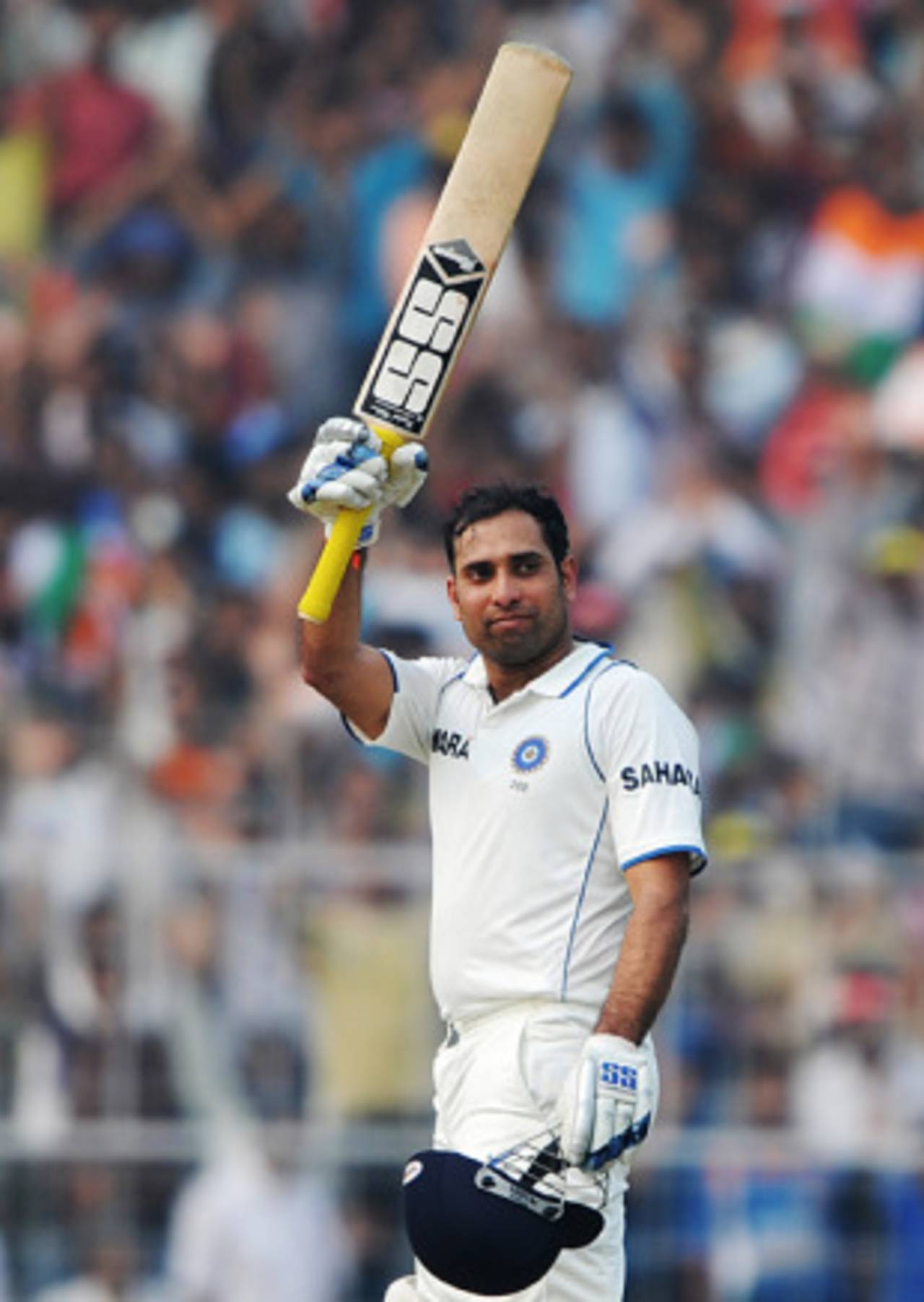A perfect fit at No. 5
VVS Laxman's style of forcing the opposition to retreat is perhaps not as in your face as MS Dhoni's, but it's as effective
N Hunter
16-Feb-2010

VVS Laxman celebrates another century at his most productive ground • AFP
MS Dhoni is right. No. 5 is the perfect position for VVS Laxman. It's where India need his abundant experience, a position that links the top order to the inexperienced middle and lower ranks. It's a position of responsibility, meant for a secure man like Laxman, who has worked hard to come to terms with his role in the team.
As soon as Laxman was declared fit for the second Test, the question was where to fit him in the batting order? His desire to bat at one drop is well known. That, coupled with his aggressive batting, which has dominated even the best Australian attacks, may have been reason enough to slot Laxman at No. 3 in Rahul Dravid's absence, especially if one of the openers fell early. But India needed an experienced hand, along with MS Dhoni, in the middle order. And so Laxman stayed at No. 5.
The series and the No. 1 ranking were at stake when Laxman walked on to Eden Gardens on Monday evening. He survived that testing period, another one on Tuesday morning and finished unbeaten with a fabulous century, his fourth at his favourite venue. Laxman became the first batsman to pass 1000 runs at Eden Gardens, and only the second Indian after Sunil Gavaskar to do so at any venue.
Artists rarely stray away from their strengths; they only improvise with a subtlety that can be missed in a blink. South Africa were caught unawares as Laxman, in the company of Dhoni, took the game away from them with the smile never leaving his face.
South Africa had regretted not sticking to their plans on the second day but at Eden Gardens, Laxman's home away from home, he knows his scoring areas so accurately that no bowler surprised him. He did fend some short deliveries in clumsy fashion and was beaten by furious outswingers from Dale Steyn and Morne Morkel. But that embarrassed smile was only an act, which masks the inner steel that Laxman seldom expresses.
Two balls before the second drinks break, JP Duminy bowled an innocuous short ball outside off stump. Laxman raised his bat high, suggesting he might cut the ball hard. Instead, he merely guided it to the fielder at point. His decision not to take advantage of such a loose ball even astonished AB de Villiers behind the stumps and both men exchanged smiles. The next ball, a wee bit fuller, was converted into a full toss as Laxman planted his left foot forward, lunged and caressed it between cover and mid off for four.
It needs a special gift to play the strokes Laxman does. He can dazzle with an array of them but his art is rooted in simplicity. Laxman had scored at least a half-century in his last seven Tests in Kolkata. He had not scored a century since his support act to Gautam Gambhir's match-saving century in Napier. The expectations of Laxman are heavy due to the success of other batsmen higher in the order.
When Laxman arrives at the crease, he is required either to give finishing touches to a strong batting performance or form a rearguard with the tail. The first role has little glamour, the second is extremely demanding. And Laxman is one of the few who play only Test cricket so each match is a challenge for him.
That he has been successful in meeting these demands is down to, in his own words, his adeptness at playing the situation. The 2009 series against Sri Lanka is a good example: in Ahmedabad, India were battling to save the Test, so Laxman had to stay put - he made 51 off 160 balls. In Kanpur and Mumbai, where Virender Sehwag had led India to record first-innings scores, he needed to score quicker and made 63 and 62. "You have to just adapt to the situation, play according to the situation, and play the role that the team gives you," he had told Cricinfo's Opening Up recently.
Today, he said he could have converted some of those starts into bigger scores. "I was a little bit disappointed that I was not able to convert my 50s and 60s into hundreds but on the positive side I am able to consistently perform for the team," Laxman said.
He was able to adapt to today's situation easily because he was batting with Dhoni. Dhoni's unorthodox method of scoring is in contrast to Laxman's picturesque handiwork but they complemented each other, forcing Graeme Smith to set defensive and well spread fields. "You can see the body language of the bowlers whenever Dhoni gets in. They are very defensive when they bowl or the way they move," Laxman.
Laxman's style of forcing the opposition to retreat is perhaps not as in your face as Dhoni's, but it's as effective.